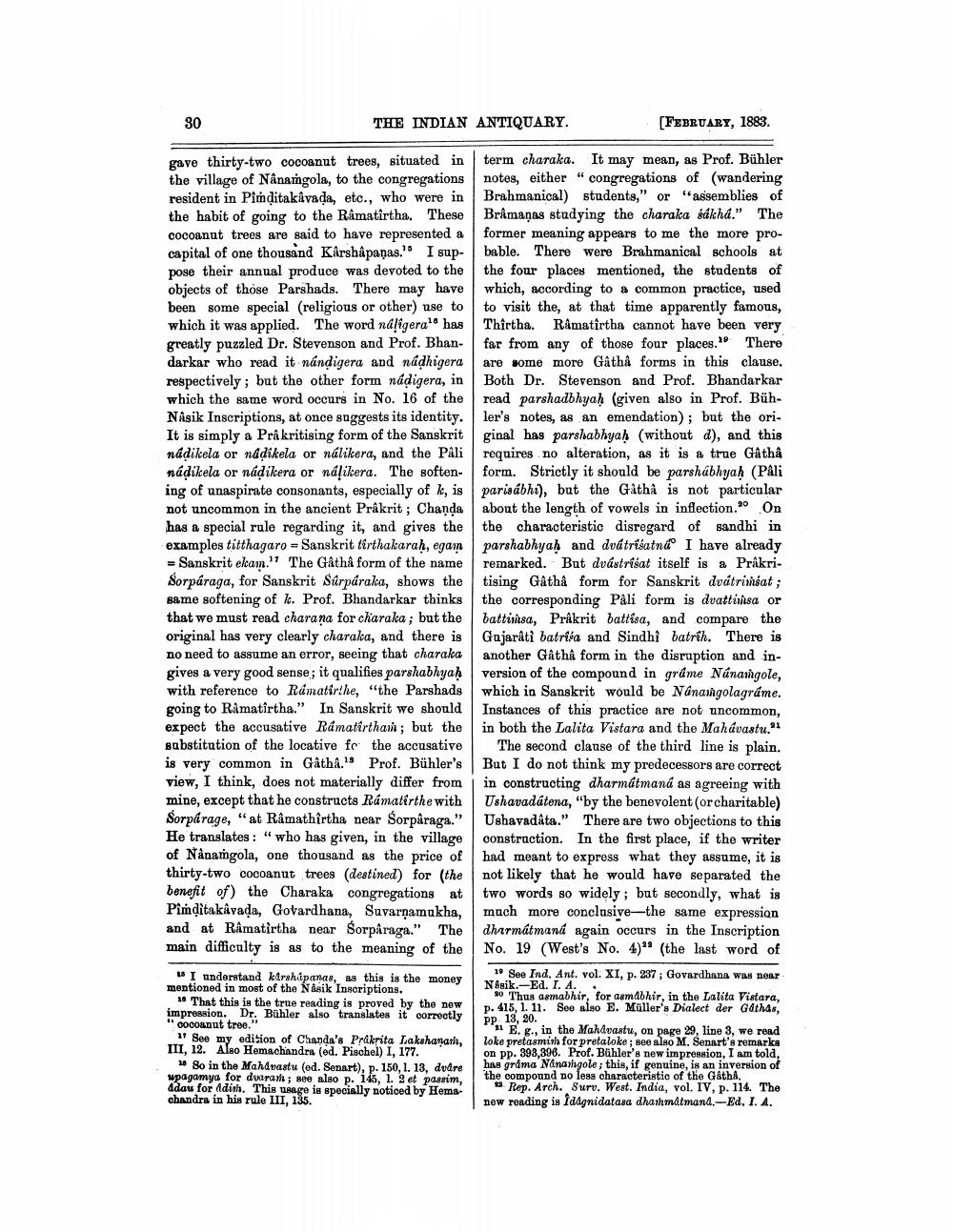________________
30
THE INDIAN ANTIQUARY.
FEBRUARY, 1883.
gave thirty-two cocoanut trees, situated in term charaka. It may mean, as Prof. Bühler the village of Nânamgola, to the congregations notes, either "congregations of (wandering resident in Pinditakávada, etc., who were in Brahmanical) students," or "assemblies of the habit of going to the Råmatirtha. These Brâmaņas studying the charaka bdkhd." The cocoanut trees are said to have represented a former meaning appears to me the more procapital of one thousand Kårshậpaņas.'' I sup- bable. There were Brahmanical schools at pose their annual produce was devoted to the the four places mentioned, the students of objects of those Parshads. There may have which, according to a common practice, used been some special (religious or other) use to to visit the, at that time apparently famous, which it was applied. The word naligera"" has Thirtha. Råmatirtha cannot have been very greatly puzzled Dr. Stevenson and Prof. Bhan- far from any of those four places. There darkar who read it nándigera and nádhigera are some more Gâthâ forms in this clause, respectively; but the other form nadigera, in Both Dr. Stevenson and Prof. Bhandarkar which the same word occurs in No. 16 of the read parshadbhyah (given also in Prof. BühNásik Inscriptions, at once suggests its identity. ler's notes, as an emendation); but the oriIt is simply a Prakritising form of the Sanskrit ginal has parshabhyah (without d), and this nadikela or nadikela or nálikera, and the Pali requires no alteration, as it is a true Gathå nádikela or nadikera or nálikera. The soften- form. Strictly it should be parshábhyah (Påli ing of unaspirate consonants, especially of k, is parisábhi), but the Gathi is not particular not uncommon in the ancient Prakrit ; Chanda about the length of vowels in inflection. On has a special rule regarding it, and gives the the characteristic disregard of sandhi in examples titthagaro = Sanskrit tirthakarah, egain parshabhyah and dvátrisatnd I have already
Sanskrit ekam." The Gatha form of the name remarked. But dvästrisat itself is a PrakriSorpáraga, for Sanskrit Sürpáraka, shows the tising Gatha form for Sanskrit dvatrimsat ; same softening of l. Prof. Bhandarkar thinks the corresponding Påli form is dvattinsa or that we must read charana for charaka; but the battinsa, Prakrit battisa, and compare the original has very clearly charaka, and there is Gajarâti batrika and Sindhi batrih. There is no need to assume an error, seeing that charaka another Gåtha form in the disruption and ingives a very good sense; it qualifies parshabhyah version of the compound in grame Nánarhgole, with reference to Ramatirthe, "the Parshads which in Sanskrit would be Nanaingolagráme. going to Råmatirtha.” In Sanskrit we should Instances of this practice are not uncommon, expect the accusative Rámatirthari; but the in both the Lalita Vistara and the Mahávastu." substitution of the locative fr the accusative The second clause of the third line is plain. is very common in Gâth.1 Prof. Bühler's But I do not think my predecessors are correct view, I think, does not materially differ from in constructing dharmátmana as agreeing with mine, except that he constructs Rámatérthe with Ushavadátena, "by the benevolent (orcharitable) Sorpárage, "at Ramathîrtha near Sorpâraga." Ushavadata." There are two objections to this He translates: "who has given, in the village construction. In the first place, if the writer of Nânamgola, one thousand as the price of had meant to express what they assume, it is thirty-two cocoanut trees (destined) for (the not likely that he would have separated the benefit of the Charaka congregations at | two words so widely; but secondly, what is Pinditakâvada, Govardhana, Suvarnamukha, much more conclusive—the same expression and at Ramatirtha near Sorparaga." The dharmatmand again occurs in the Inscription main difficulty is as to the meaning of the No. 19 (West's No. 4)" (the last word of 16 I understand kirshúpanas, as this is the money
19 See Ind. Ant. vol. XI, p. 237; Govardhana was near mentioned in most of the N isik Inscriptions.
Nasik.-Ed. I. A. . 10 That this is the true reading is proved by the new
90 Thus asmabhir, for asmabhir, in the Lalita Vistara, impression. Dr. Bühler also translates it
p. 415, 1. 11. See also E. Müller's Dialect der Gathas,
correctly pp. 13, 20. "cocoanut tree."
**E. g., in the Mahavastu, on page 29, line 3, we read 11 See my edition of Chanda's Prakrita Takahanath, loke pretasmish for pretaloke; see also M. Senart's remarks III, 12. Also Hemachandra (ed. Pischel) I, 177.
on pp. 398.896. Prof. Bühler's new impression, I am told, » So in the Mahdvastu (ed. Senart), p. 150, 1. 13, dvdre
has grama Nanavigole; this, if genuine, is an inversion of wpagamya for dvaran; see also p. 145, 1. 2 et passim,
the compound no less characteristic of the Gath. ddau for Adith. This usage is specially noticed by Hema
Rep. Arch. Surv. West. India, vol. IV, p. 114. The chandra in his rule III, 135.
now reading is Idägnidatasa dhammdtmana.-Ed. I. A.




